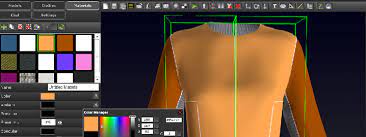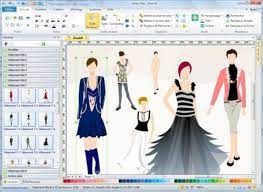What is Fashion Cad Course? Is CAD Designer a Great Career?
Fashion Cad Course:
Fashion CAD (computer-aided design) is a type of software that is specifically designed for fashion designers to create digital fashion designs. In today’s fashion industry, fashion CAD has become an essential tool for designers to create and present their designs to clients and manufacturers.
Fashion CAD courses are designed to teach students how to use the software to create professional-looking designs. These courses typically cover the basics of the software, including how to use the various tools and features, how to create and manipulate designs, and how to create accurate patterns and measurements.

The curriculum of a Fashion CAD course may vary depending on the institution offering it. However, some of the topics that are usually covered in these courses include:
- Introduction to Fashion CAD: This covers the basics of the software, including the interface, tools, and features. Students learn how to navigate the software and create basic designs.
- Sketching and Drawing: This covers the basics of sketching and drawing on the software. Students learn how to use the different brushes, colors, and textures to create a range of designs.
- Pattern Making: This covers the creation of patterns using the software. Students learn how to take accurate measurements and create custom patterns based on those measurements.
- Garment Construction: This covers the construction of garments using the software. Students learn how to create a range of garment types, including dresses, jackets, pants, and more.
- Fabric and Texture: This covers the use of different fabrics and textures in fashion design. Students learn how to create digital swatches of fabrics and how to apply them to designs.
- Rendering: This covers the process of rendering digital designs to create realistic 3D models. Students learn how to use lighting, shading, and other techniques to create a realistic final product.
- Portfolio Development: This covers the process of creating a professional portfolio of digital designs. Students learn how to showcase their work and present it to potential clients or employers.
In addition to these topics, Fashion CAD courses may also cover topics such as color theory, trend forecasting, and fashion history.

Overall, Fashion CAD courses are designed to prepare students for a career in the fashion industry by teaching them the essential skills needed to use this important software. With the rise of digital technology in the fashion industry, knowledge of Fashion CAD is now an essential skill for anyone looking to succeed as a fashion designer or garment manufacturer.
Is CAD Designer a Great Career?
A CAD (computer-aided design) designer is a professional who uses software to create 2D or 3D designs for various industries such as architecture, engineering, and product design. CAD designers use specialized software to create detailed plans, technical drawings, and models that help to visualize products and structures before they are built. The question of whether CAD designing is a great career choice depends on various factors.
Advancements in technology have led to an increase in demand for CAD designers across industries. As such, the field of CAD design is highly sought after, and becoming a CAD designer can be a great career choice for those interested in design, engineering, and innovation.

One of the advantages of pursuing a career in CAD design is the potential for high earnings. According to the U.S. Bureau of Labor Statistics, the median annual wage for drafters, including CAD designers, was $58,050 in May 2020. Additionally, many CAD designers work as independent contractors or freelancers, allowing them to set their own rates and work on a flexible schedule.
Another advantage of being a CAD designer is the opportunity to work on a wide range of projects. CAD designers can work in various industries, including architecture, engineering, manufacturing, and product design. This allows them to explore their interests and develop expertise in specific areas.
Furthermore, CAD designers play a crucial role in the product development process. They work alongside engineers and product designers to develop detailed designs and models, which help to refine the product before it is manufactured. This can save time and money in the long run, as design flaws can be identified and fixed before the product is built.
CAD design also offers the potential for career growth and development. As a CAD designer gains experience, they may be given more complex projects to work on, or they may be promoted to a management position, such as a project manager or team leader. Additionally, CAD designers can take on additional responsibilities, such as training new designers or mentoring junior designers.

However, there are some potential drawbacks to pursuing a career in CAD design. One of the main challenges is the potential for repetitive work. Depending on the industry and the specific project, CAD designers may be required to create multiple iterations of the same design, which can be tedious and monotonous.
Another potential challenge is the need for ongoing training and education. CAD design software is constantly evolving, and designers need to keep up with new features and tools. Additionally, as new technologies emerge, such as 3D printing and virtual reality, CAD designers may need to learn new skills to remain competitive.
Fashion Cad Course:
Fashion CAD (computer-aided design) is a type of software that is specifically designed for fashion designers to create digital fashion designs. In today’s fashion industry, fashion CAD has become an essential tool for designers to create and present their designs to clients and manufacturers.
Fashion CAD courses are designed to teach students how to use the software to create professional-looking designs. These courses typically cover the basics of the software, including how to use the various tools and features, how to create and manipulate designs, and how to create accurate patterns and measurements.

The curriculum of a Fashion CAD course may vary depending on the institution offering it. However, some of the topics that are usually covered in these courses include:
- Introduction to Fashion CAD: This covers the basics of the software, including the interface, tools, and features. Students learn how to navigate the software and create basic designs.
- Sketching and Drawing: This covers the basics of sketching and drawing on the software. Students learn how to use the different brushes, colors, and textures to create a range of designs.
- Pattern Making: This covers the creation of patterns using the software. Students learn how to take accurate measurements and create custom patterns based on those measurements.
- Garment Construction: This covers the construction of garments using the software. Students learn how to create a range of garment types, including dresses, jackets, pants, and more.
- Fabric and Texture: This covers the use of different fabrics and textures in fashion design. Students learn how to create digital swatches of fabrics and how to apply them to designs.
- Rendering: This covers the process of rendering digital designs to create realistic 3D models. Students learn how to use lighting, shading, and other techniques to create a realistic final product.
- Portfolio Development: This covers the process of creating a professional portfolio of digital designs. Students learn how to showcase their work and present it to potential clients or employers.
In addition to these topics, Fashion CAD courses may also cover topics such as color theory, trend forecasting, and fashion history.
Overall, Fashion CAD courses are designed to prepare students for a career in the fashion industry by teaching them the essential skills needed to use this important software. With the rise of digital technology in the fashion industry, knowledge of Fashion CAD is now an essential skill for anyone looking to succeed as a fashion designer or garment manufacturer.
Is CAD Designer a Great Career?
A CAD (computer-aided design) designer is a professional who uses software to create 2D or 3D designs for various industries such as architecture, engineering, and product design. CAD designers use specialized software to create detailed plans, technical drawings, and models that help to visualize products and structures before they are built. The question of whether CAD designing is a great career choice depends on various factors.
Advancements in technology have led to an increase in demand for CAD designers across industries. As such, the field of CAD design is highly sought after, and becoming a CAD designer can be a great career choice for those interested in design, engineering, and innovation.

One of the advantages of pursuing a career in CAD design is the potential for high earnings. According to the U.S. Bureau of Labor Statistics, the median annual wage for drafters, including CAD designers, was $58,050 in May 2020. Additionally, many CAD designers work as independent contractors or freelancers, allowing them to set their own rates and work on a flexible schedule.
Another advantage of being a CAD designer is the opportunity to work on a wide range of projects. CAD designers can work in various industries, including architecture, engineering, manufacturing, and product design. This allows them to explore their interests and develop expertise in specific areas.
Furthermore, CAD designers play a crucial role in the product development process. They work alongside engineers and product designers to develop detailed designs and models, which help to refine the product before it is manufactured. This can save time and money in the long run, as design flaws can be identified and fixed before the product is built.
CAD design also offers the potential for career growth and development. As a CAD designer gains experience, they may be given more complex projects to work on, or they may be promoted to a management position, such as a project manager or team leader. Additionally, CAD designers can take on additional responsibilities, such as training new designers or mentoring junior designers.
However, there are some potential drawbacks to pursuing a career in CAD design. One of the main challenges is the potential for repetitive work. Depending on the industry and the specific project, CAD designers may be required to create multiple iterations of the same design, which can be tedious and monotonous.
Another potential challenge is the need for ongoing training and education. CAD design software is constantly evolving, and designers need to keep up with new features and tools. Additionally, as new technologies emerge, such as 3D printing and virtual reality, CAD designers may need to learn new skills to remain competitive.








